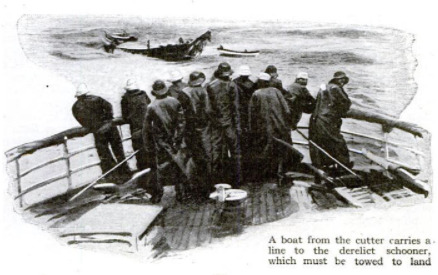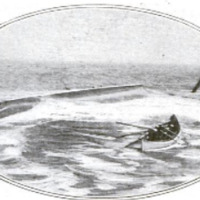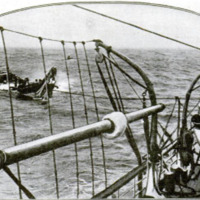-
Titolo
-
How U. S. Coast Guard removes floating derelicts in the Atlantic Ocean
-
Article Title and/or Image Caption
-
Title: The Derelict-Rival of the U-Boat
-
How the Coast Guard fights the grimmest menace of the sea
-
extracted text
-
PEACE hath its perils no less than
Price paraphrase famous
saying; and, while the menace
of the submarine has been re-
moved by the victory of the
Allies, the Coast Guard
must continue its never-
ending warfare against the
derelict.
“Another chapter has
been added to the mysteries
of the saw often have
you not read that in a news-
paper account of a ship that
never returned? Such are the
vicissitudes of storms and tidal waves,
so-called, that the reason for many dis-
appearances can never be known. But
the men who sail the Seven Seas be-
lieve that derelicts, the grimmest
menace of the sea in peace times, are
responsible for many marine disasters.
Such is the danger of the derelict
that it became one of the leading sub-
jects of discussion at an international
conference of the maritime powers held
at Washington in
1890. The confer-
ence recognized the
importance of a
systematic removal
of derelicts from the
paths of commerce,
and adopted resolu-
tions that something
should be done. But
after a few spas-
modic efforts the
Government again
lapsed into indiffer-
ence.
By 1906 the mari-
time interests of the
leading Atlantic sea-
ports appealed forei-
bly to Congress. An
act was passed au-
thorizing the construction of a special
derelict destroyer, and the responsibility
for systematically destroying derelicts
was placed upon the Revenue Cutter
Service, now the Coast Guard. The ves-
sel was completed in 1907, and the larger
revenue cutters were outfitted with
submarine mines and other appa-
ratus. Forthelasttenyearsthe
work of destroying derelicts
hasbeen vigorously carried on.
In general, there are but
two types of derelicts:
sunkenand floating. Sunk-
en derelicts, with their
spars projecting above
water, are generally found
in the routes of coastwise
traffic. Floating derelicts
drift promiscuously about at
the impulse of current and wind,
but sooner or later find their devious
way into the steamship lanes.
How many people realize that the
waters along the greater part of our
Atlantic coast, owing to the gradual
slope of the bottom for a distance of
thirty to fifty miles, are in many places
not more than from ten to twenty-five
fathoms deep? No wonder that when
sailing-vessels, and even steamers, are
sunk off the Atlantic
coast, their spars
project well above
water—a menace to
every ship that plies
the near-by waters.
In these days of
radio communica-
tion it is not a mat-
ter of great difficulty
to locate a wreck,
and the nearest
available cutter be-
gins search at once.
Even if the wreck is
soon found the cutter
must often “heave
to" and await good
weather conditiors.
‘The handling of gun-
cotton mines and the
necessary detonating apparatus in
small boats, tossed about in rough
water, is not, as may well be imagined,
the safest of occupations. Carefully
the mine is secured to the projecting
‘mast by a bridle, and attached to a
water-proofed electric cable. Then it
is allowed to slip down to the foot of
the spar. Off rows the boat to a safe
distance, One vigorous downward
thrust of the magneto, and there is a
Sol) roar. Hundreds of tons. of sea
water are cascaded upward.
In the midst of the mass
of glittering white
‘water 1s the huge
spar, jerked loose
from its steel
shrouds. Two,
three, four, five,
and sometimes six
times the boat re-
turns and places
‘mines, depending
upon the number
of masts in the
sunken vessel.
Wreckage Must
Be Towed Away
Even when all
the spars are
blown up, the
task of the cutter
is not completed.
Frequently the
wreckage is tan-
gled in steel stays
and shrouds, which must be cut. The
spars are usually lashed together and
towed to shore. ~ After all the spars in
sight have been removed, soundings
are taken over the wreck, and the in-
formation thus obtained is dissemi-
nated to shipmasters through Hydro-
graphic Office bulletins.
Floating derelicts, although less
‘numerous, are much more difficult to
remove. The records of a decade
show that fully ninety-five per cent
of floating dereliets are lumber-laden,
the timber in their holds keeping them
afloat. Statistics also show that the
stormy waters within a radius of one
hundred miles of Cape Hatteras are re-
sponsible for most floating derelicts.
Two_cutters are stationed in that
vicinity.
At first, attempts to locate these
ocean waifs were not succcessful, but
navigating officers have now evolved
systems of search whereby failure
bas become less frequent. At first it
was the practice to follow a zigzag
course in the direction which it was
assumed the wanderer might have
taken. Searching after this fashion
was mere guessing.
Nowadays the “spiral system” is
employed. A cutter starts from the
position where the derelict was last
sighted, and from that point steers
a series of courses approximating a
spiral curve, the distance between the
convolutions being equal to twice the
radius of visibility, or the distance at
which the object could be discerned
from a lookout in the crow's-nest. In
clear weather, and with portions of the
spars on the wreck still standing, this
radius can safely be taken as five
miles, so that the distance between
the convolutions of the spiral will be
ten miles. Since a derelict must be
sought in daylight, a lineal distance of
about 145 miles can be covered in one
day's crulsing by the average cutter.
In spiral cruising one day's searching
under ordinary conditions will make it
reasonably sure that the derelict is not
within an area of 1522 square miles.
On several occasions this method has
met with success within a few hours.
Derelicts Towed to Port
Floating derelicts, when found, are
not destroyed. In fact, it is almost
impossible to destroy them. To blow
the drifting wreck out of the way is
simply to heighten the danger. Burn-
ing is usually ineffective; the upper
‘works alone are consumed, because the
seas extinguish the flames as they near
the water's edge. There is but one
sure way of removing these terrors
from the seas. They must be tediously
towed to the nearest port.
Most, difficult of all to handle is the
bottom-up derelict which has been
capsized with all sails set. It is hard
to find, because of the small amount of
exposed surface above the water, and
it is still harder to tow, because
there is no place to which to
fusten a tow-line, and be-
cause spars and resist-
ant sails project
from ninety to one
Jundrec and
twenty-five feet
below the water.
The boat crew
must approach
the slippery bot-
tom of the dere-
lit cautiously
to prevent be-
ing dashed upon
it by the sea.
Picking their mo-
ment, they jump
on the upturned
craft and cling to
the keel, the only
projection avail-
able. Even then
they are in danger
of being washed
off by some break-
ing sea. A long
iron strap is fastened to the bottom
of the keel by a number of ten-inch
spikes. At the end of the strap is a
ring through which the towing-line is
secured.
‘Towing is wearisomely slow. As the
coast is approached the masts strike
bottom and break off. Such wrecks
are difficult to get into harbor, and
so they are sometimes grounded and
allowed to wash up on the beach in
an onshore storm. Probably three
fourths of all the floating derelicts
recovered are repaired and put back
into use.
An International Derelict Patrol
For the ten-year period ended June
30, 1916, covering the entire time in
which records of dereliet work have
been kept, 268 derelicts have been de-
stroyed or removed. At the Inter-
national Conference on Safety at Sea,
in session at London in 1913, brought
about by the loss of the Titanic, the
delegates from all the great maritime
powers voted unanimously to invite
the United States to undertake to rid
the entire North Atlantic Ocean of
derelicts. Unfortunately, before the
convention could be ratified by the
several governments involved, the war
broke out, and the international dere-
lict patrol was, temporarily at least,
‘postponed. .
-
Autore secondario
-
C. A. McAllister (Article writer)
-
Lingua
-
eng
-
Data di rilascio
-
1919-02
-
pagine
-
13-14
-
Diritti
-
Public domain (Google digitized)
-
Archived by
-
Davide Donà
-
Marco Bortolami (editor)





